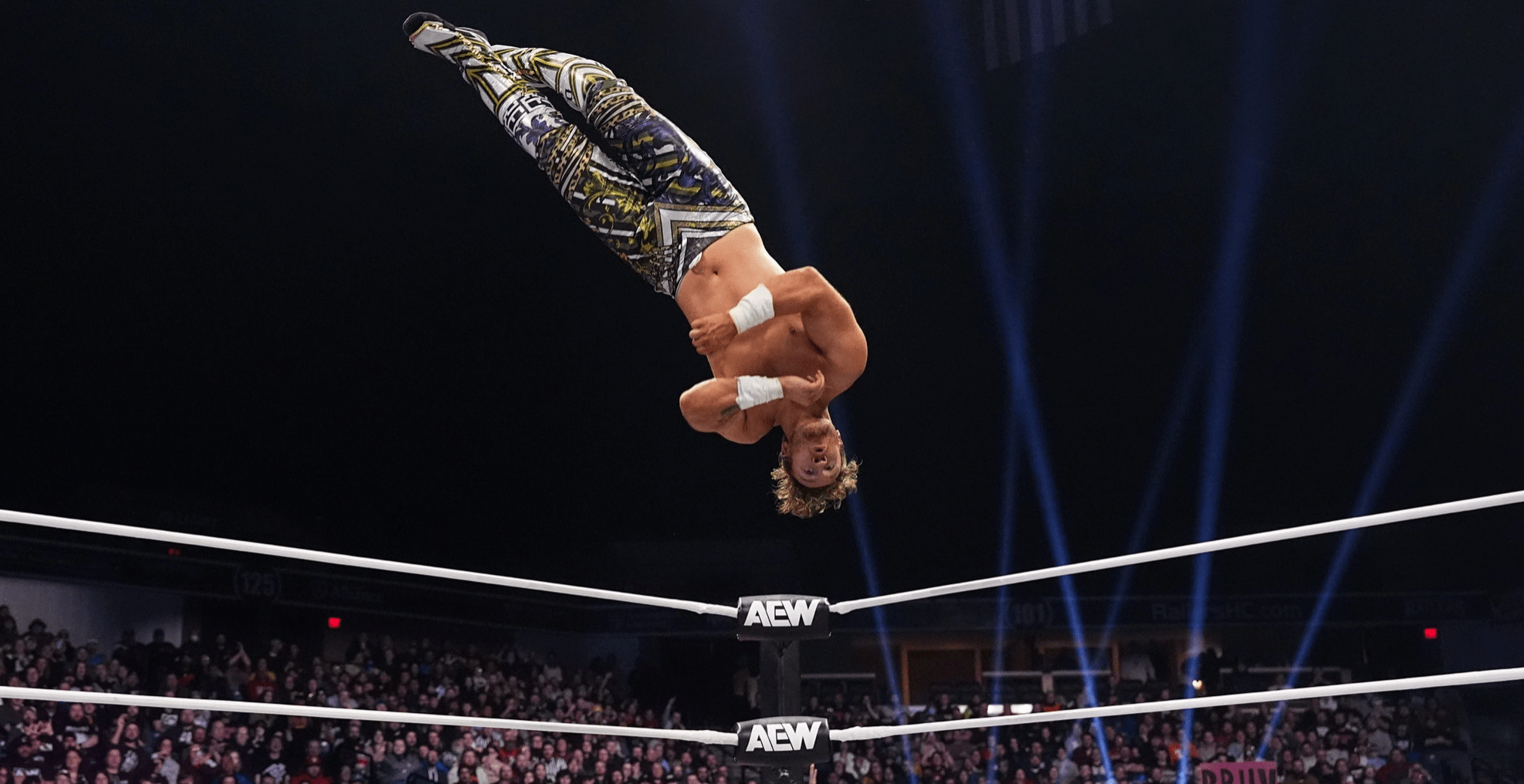For the past week, professional wrestling has occupied the apex of the entertainment industry.
That’s a sentence that might have been unthinkable 10 years ago, when the art form that began as a carnival act in the 1800s before evolving into a multi-billion dollar scripted sports industry was seen by many as an unsophisticated (if endlessly profitable) laughingstock. But a recent influx in critically acclaimed storytelling, major international free agents, and behind-the-scenes disruption has given the wrestling business a shot of adrenaline that turned it into must-see TV in the 2020s.
Years of rapidly accelerating momentum built to a head during the first week in April, when America’s two biggest wrestling promotions, World Wrestling Entertainment and All Elite Wrestling, pulled the trigger on some of their longest-gestating storylines to produce some electrifying television. It began on Sunday night, when WWE’s longtime champion Roman Reigns finally saw his villainous title run end after nearly four years of dominance, dropping his belt to rising superstar Cody Rhodes in a star-studded match (featuring cameos from the likes of Dwayne Johnson and John Cena) that helped turn WrestleMania 40 into the most watched Peacock broadcast of all time, with 1.3 billion minutes streamed.
That momentous event could have been the kind of climax that sent the industry into a long cooling off period. But the beauty of professional wrestling in 2024 is that the intense competition between companies ensures that there’s never a dull moment. AEW, Tony Khan’s disruptive promotion that airs weekly wrestling shows on TBS and TNT, followed the historic event by stoking some drama of its own.
For the past year, wrestling industry news outlets have been dominated by a real-life feud involving CM Punk, the WWE legend who un-retired in 2021 for an acclaimed run on AEW that ended tumultuously after he was fired over a backstage altercation at a show at Wembley Stadium. Punk had subsequently returned to WWE, but the specific details of his backstage drama at AEW had consumed the Twitter feeds of hardcore fans who follow wrestling 365 days a year. In a shocking decision, Khan capitalized on wrestling’s hot moment to release the year-old private footage from Wembley Stadium on Wednesday night’s “AEW Dynamite” show, combining real-life drama and wrestling storytelling to create one of the industry’s most viral moments in years.
In a recent conversation with IndieWire, Khan basked in the moment while acknowledging the hard work that it took to restore wrestling to such a prominent place in pop culture.

“There’s a number of big factors that would play into why wrestling has seen such a great renaissance in recent years. I think it comes from the great competition in wrestling right now, and the fact that there are so many great stars competing right now,” Khan said. “Everyone knows that the most real thing in wrestling is the competition between the companies. The companies hate each other, and it will be a natural resource that powers the industry. They want to beat each other and take everybody’s free agents, and that makes it interesting for everybody else.”
Wrestling’s recent run of artistic and commercial success have created a moment that Hollywood would be ill-advised to ignore. As the medium continues to draw in new fans at an electrifying rate, the film and television industry should take note of three major takeaways.
The Path from Wrestling to Movie Stardom Is Now a Two-Way Street
Wrestling stars abandoning the ring to try their hand at Hollywood acting is a tale as old as time. But the trend of former wrestlers pausing their thriving movie careers to take on full-time wrestling schedules is a new development that speaks to the cultural relevance of wrestling in 2024.
For years, Dwayne Johnson has represented the platonic ideal of the wrestling-to-acting success story, parlaying his WWE career into a run as Hollywood’s biggest action star in projects as varied as “Fast and Furious” movies and Benny Safdie’s upcoming A24 drama “The Smashing Machine.” Those lucrative roles and some savvy business decisions turned him into a billion dollar brand that sells endless amounts of tequila, fitness gear, and skincare products. Nobody would have blamed him if he decided to leave the physically grueling and often critically ignored world of wrestling for good.
But The Rock did the opposite of that, returning to WWE for an acclaimed three month storyline that culminated in one of the biggest matches of his career on night one of WrestleMania 40. He’s already appeared on TV to set up the story for his next big match against Cody Rhodes (presumably at next year’s WrestleMania 41), and shows no signs of giving his wrestling career any less attention than his film work.
The other biggest Hollywood asset to emerge from wrestling in recent years is John Cena, who has slowly but steadily become one of the film industry’s most reliable comedic leading men. But after making a brief WrestleMania cameo on Sunday night, he teased that he’s eager to pause his acting career for another full time wrestling run.
“I’m crossing my fingers and toes and my heart that maybe, just maybe, I can tell the Hollywood world to pump the brakes for a while and come back to my family for one last run,” Cena said in an interview on The Pat McAfee Show the day after his WrestleMania appearance.
The message is clear: Professional wrestling is currently able to offer A-list performers a level of creative fulfillment and financial compensation that rivals what they can get in Hollywood. The film industry should ignore the phenomenon at its own peril.
No Industry Is Doing a Better Job of Introducing International Stars to American Audiences
In an increasingly globalized entertainment marketplace, smart companies need to constantly be on the lookout for elite international talent. Figuring out how to market international talent to a domestic audience without losing their original fanbase is an art form in and of itself, and few organizations have done a better job of it in recent years than AEW.
It could be argued that the two hottest performers on the company’s roster are Will Ospreay, the British wrestler known for his elite aerial acrobatics; and Kazuchika Okada, the legendary Japanese heel who many wrestling geeks regard as one of the best in-ring performers in history. While both men made names for themselves wrestling in Japan, they signed with AEW in early 2024 in two of the most high profile wrestling free agency deals in recent memory. While their talents as performers arguably could have made them stars in any era, Khan explained that the internet has made it easier than ever for wrestlers to build international fanbases.
“It’s been very exciting to bring a lot of the top free agents in, and many of them are international stars that are being introduced to some fans on American television for the first time ever,” Khan said. “I think now, in a digital era where the information is at our fingertips and entire libraries of matches are at our fingertips, it’s more feasible than ever for fans to familiarize themselves and for these wrestlers to connect with the domestic audience upon arrival.”
The process of placing huge bets on international performers, elevating them with the same marketing pushes as American stars, and trusting fans to be culturally literate enough to embrace them is a strategy that continues to pay dividends for the wrestling industry. There’s no reason to believe Hollywood couldn’t enjoy similar success by embracing the formula more.
Wrestling Continues to Prove That Entertainment Monopolies Are Not Impenetrable
Ask any working creative or hardcore film fan about their biggest frustration with the entertainment business, and you’re likely to get some variation of the same answer: The highest levels of the industry have become monopolized by a handful of increasingly risk-averse companies, which has resulted in creative stagnation that creates a worse product for everyone.
It wasn’t long ago that wrestling was in a similar position. While the industry has a rich history of small promotions known as “territories” creating geographically specific wrestling products, the industry was gradually devoured by Vince McMahon’s behemoth that came to be known as WWE. For much of the 21st century, WWE programming was the only viable option for fans looking to watch American wrestling on TV. Many felt that the 2010s were a dark creative period for the industry in large part because the lack of competition had rendered creative risktaking unnecessary.
The launch of AEW in 2019 changed all of that. Khan’s aggressive approach quickly turned the upstart company into a TV juggernaut in its own right, and bold choices such as signing major international stars and taking creative cues from real combat sports broadcasts quickly established it as the first legitimate competition that WWE had faced in years.
“AEW is a challenger brand in the pro wrestling industry. When we started All Elite Wrestling, pro wrestling had been a monopoly for about 20 years,” Khan said. “It was something that was really important to me to create an alternative pro wrestling promotion with a major following.”
The competition forced both companies to up their creative game, creating what many fans have labeled a new golden age of wrestling in the 2020s. The rise of AEW has also led to increased interest in many smaller independent wrestling promotions, as fans have clearly internalized the idea that there’s room in wrestling for anyone creative enough to try something new.
In a time when many cinephiles and TV junkies lament the dominance of recycled studio franchises and all-powerful streaming algorithms, wrestling’s revival is a reminder that the entertainment industry could just be one disrupter away from a renaissance of its own.





